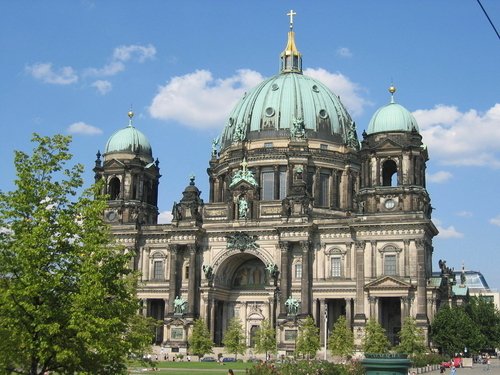In Baroque architecture, new emphasis was placed on bold massing, colonnades, domes, light-and-shade (chiaroscuro), 'painterly' color effects, and the bold play of volume and void. In interiors, Baroque movement around and through a void informed monumental staircases that had no parallel in previous architecture. The other Baroque innovation in worldly interiors was the state apartment, a processional sequence of increasingly rich interiors that culminated in a presence chamber or throne room or a state bedroom. The sequence of monumental stairs followed by a state apartment was copied in smaller scale everywhere in aristocratic dwellings of any pretensions.
Baroque architecture was taken up with enthusiasm in central Germany (see e.g. Ludwigsbur Palace and Zwinger Dresden), Austria and Russia (see e.g. Peterhof). In England the culmination of Baroque architecture was embodied in work by Sir Christopher Wren, Sir John Vanbrugh and Nicholas Hawksmoor, from ca. 1660 to ca. 1725. Many examples of Baroque architecture and town planning are found in other European towns, and in Latin America. Town planning of this period featured radiating avenues intersecting in squares, which took cues from Baroque garden plans.In Sicily, Baroque developed new shapes and themes as in Noto, Ragusa and Acireale "Basilica di San Sebastiano".Architecture, departing from the classical canon revived during the Renaissance, took on the fluid, plastic aspects of sculpture. Buildings of the period are composed of great curving forms with undulating facades, ground plans of unprecedented size and complexity, and domes of various shapes.Many works of baroque architecture were executed on a colossal scale, incorporating aspects of urban planning and landscape architecture.Many works of Baroque sculpture are set within elaborate architectural settings, and they often seem to be spilling out of their assigned niches or floating upward toward heaven.
Етикети:
Other styles
Baroque architecture was taken up with enthusiasm in central Germany (see e.g. Ludwigsbur Palace and Zwinger Dresden), Austria and Russia (see e.g. Peterhof). In England the culmination of Baroque architecture was embodied in work by Sir Christopher Wren, Sir John Vanbrugh and Nicholas Hawksmoor, from ca. 1660 to ca. 1725. Many examples of Baroque architecture and town planning are found in other European towns, and in Latin America. Town planning of this period featured radiating avenues intersecting in squares, which took cues from Baroque garden plans.In Sicily, Baroque developed new shapes and themes as in Noto, Ragusa and Acireale "Basilica di San Sebastiano".Architecture, departing from the classical canon revived during the Renaissance, took on the fluid, plastic aspects of sculpture. Buildings of the period are composed of great curving forms with undulating facades, ground plans of unprecedented size and complexity, and domes of various shapes.Many works of baroque architecture were executed on a colossal scale, incorporating aspects of urban planning and landscape architecture.Many works of Baroque sculpture are set within elaborate architectural settings, and they often seem to be spilling out of their assigned niches or floating upward toward heaven.


1 коментара:
Baroque architecture developed in Rome in the early 17th century, directly following the Renaissance. Its popularity was directly tied to ...
Post a Comment